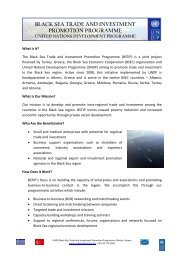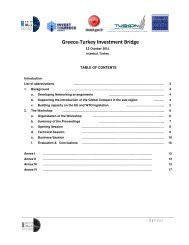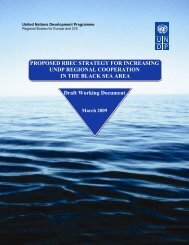Tradeflow Study - UNDP Black Sea Trade and Investment Promotion ...
Tradeflow Study - UNDP Black Sea Trade and Investment Promotion ...
Tradeflow Study - UNDP Black Sea Trade and Investment Promotion ...
You also want an ePaper? Increase the reach of your titles
YUMPU automatically turns print PDFs into web optimized ePapers that Google loves.
Annex 2. Methodology for calculating trade potential <strong>and</strong> results<br />
Annex 2.1. Methodological aspects of Gravity Equations<br />
The <strong>Trade</strong> potential calculated using the gravity equation is obtained from the International<br />
<strong>Trade</strong> Centre’s <strong>Trade</strong>Sim model. <strong>Trade</strong>Sim takes into account a number of factors such as<br />
market size, conflicts, tariffs, cultural proximity, distance between cities , etc. The <strong>Trade</strong>Sim<br />
model calculates the expect trade that would take place between countries based on these<br />
variables. Formally, the equation is given as:<br />
X<br />
ijk<br />
ik<br />
<br />
jk<br />
0k<br />
1<br />
k<br />
ln Dij<br />
2k<br />
ln Tijk<br />
3k<br />
ln Bij<br />
4k<br />
ln Lij<br />
5k<br />
ln Cij<br />
6k<br />
G<br />
ij<br />
<br />
ijk<br />
Where i: exporting country; j: importing country; k: sector<br />
X ijk : <strong>Trade</strong> in sector k from country i to country j<br />
D ij : Distance between country i <strong>and</strong> country j<br />
B ij : Border between country i <strong>and</strong> country j (Equals 1 if bordering; 0 otherwise)<br />
T ijk : Tariff between country i <strong>and</strong> country j in sector k<br />
L ij : Language common to country i <strong>and</strong> country j (Equals 1 if the same; 0 otherwise)<br />
C ij : Existence of conflict between country i <strong>and</strong> country j (Equals 1 if conflict; 0 otherwise)<br />
G ij : Bilateral measure of geographical location<br />
ik , jk : Multilateral resistence terms<br />
With only minor exceptions (for example for energy products), the model yields the expected<br />
results from economic theory, namely that tariffs ( 2 ) impact negatively on bilateral trade, as<br />
do conflicts ( 5 ) <strong>and</strong> transport costs – measured by distances between major trading cities<br />
( 1 ). On the other h<strong>and</strong>, the economic size of trading partners (measured by GDP) ( 0 ),<br />
bordering countries ( 3 ), <strong>and</strong> common languages ( 4 ) have a positive influence on bilateral<br />
trade flows. The bilateral measure of geographical location ( 3 ) captures country specific<br />
characteristics based on the assumption that countries with similar geographical<br />
characteristics are likely to have similar comparative advantages <strong>and</strong> thus trade less. The<br />
bilateral location variable is captured using the country’s latitude, taking a value of 1 if both<br />
countries belong to the same hemisphere, using a 20° latitude line as division criterion, <strong>and</strong> 0<br />
otherwise.<br />
<strong>Trade</strong> data is constructed from UNSD Comtrade Database for averages of 2002-03 data.<br />
Tariff data is obtained from MacMaps <strong>and</strong> sectors are defined according to the ISIC 19<br />
industrial sectors. Distances are calculated according to the great circle distance between<br />
95/135






